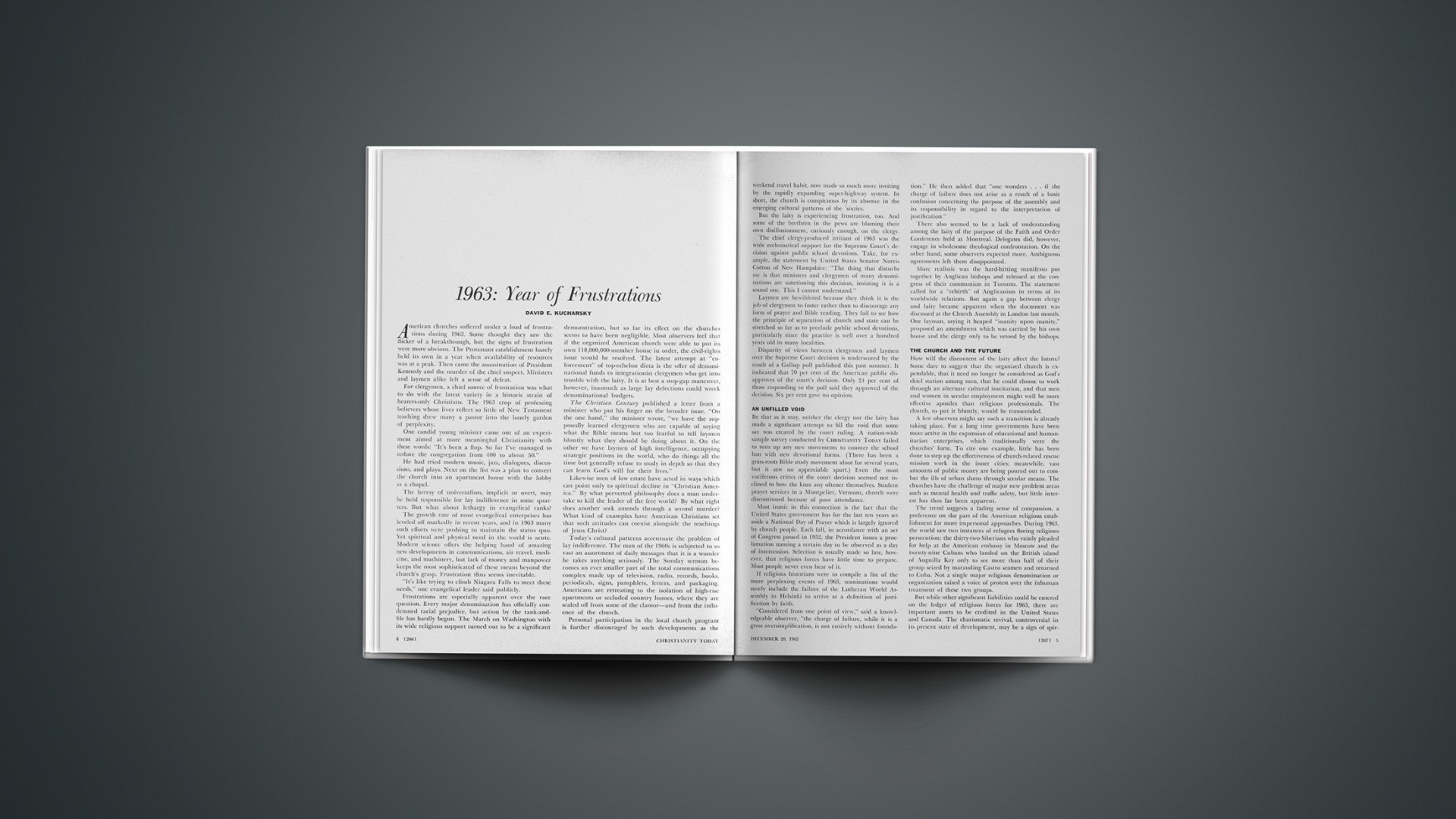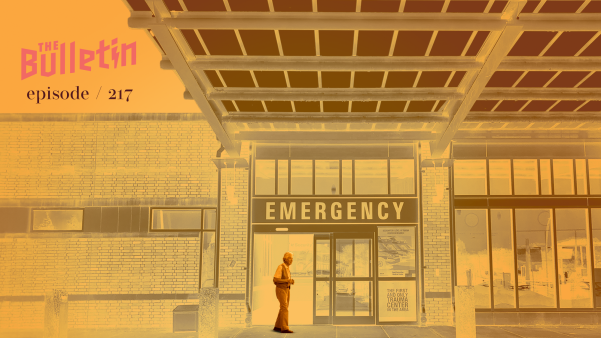American churches suffered under a load of frustrations during 1963. Some thought they saw the flicker of a breakthrough, but the signs of frustration were more obvious. The Protestant establishment barely held its own in a year when availability of resources was at a peak. Then came the assassination of President Kennedy and the murder of the chief suspect. Ministers and laymen alike felt a sense of defeat.
For clergymen, a chief source of frustration was what to do with the latest variety in a historic strain of hearers-only Christians. The 1963 crop of professing believers whose lives reflect so little of New Testament teaching drew many a pastor into the lonely garden of perplexity.
One candid young minister came out of an experiment aimed at more meaningful Christianity with these words: “It’s been a flop. So far I’ve managed to reduce the congregation from 400 to about 50.”
He had tried modern music, jazz, dialogues, discussions, and plays. Next on the list was a plan to convert the church into an apartment house with the lobby as a chapel.
The heresy of universalism, implicit or overt, may be held responsible for lay indifference in some quarters. But what about lethargy in evangelical ranks?
The growth rate of most evangelical enterprises has leveled off markedly in recent years, and in 1963 many such efforts were pushing to maintain the status quo. Yet spiritual and physical need in the world is acute. Modern science offers the helping hand of amazing new developments in communications, air travel, medicine, and machinery, but lack of money and manpower keeps the most sophisticated of these means beyond the church’s grasp. Frustration thus seems inevitable.
“It’s like trying to climb Niagara Falls to meet these needs,” one evangelical leader said publicly.
Frustrations are especially apparent over the race question. Every major denomination has officially condemned racial prejudice, but action by the rank-and-file has hardly begun. The March on Washington with its wide religious support turned out to be a significant demonstration, but so far its effect on the churches seems to have been negligible. Most observers feel that if the organized American church were able to put its own 118,000,000-member house in order, the civil-rights issue would be resolved. The latest attempt at “enforcement” of top-echelon dicta is the offer of denominational funds to integrationist clergymen who get into trouble with the laity. It is at best a stop-gap maneuver, however, inasmuch as large lay defections could wreck denominational budgets.
The Christian Century published a letter from a minister who put his finger on the broader issue. “On the one hand,” the minister wrote, “we have the supposedly learned clergymen who are capable of saying what the Bible means but too fearful to tell laymen bluntly what they should be doing about it. On the other we have laymen of high intelligence, occupying strategic positions in the world, who do things all the time but generally refuse to study in depth so that they can learn God’s will for their lives.”
Likewise men of low estate have acted in ways which can point only to spiritual decline in “Christian America.” By what perverted philosophy does a man undertake to kill the leader of the free world? By what right does another seek amends through a second murder? What kind of examples have American Christians set that such attitudes can coexist alongside the teachings of Jesus Christ?
Today’s cultural patterns accentuate the problem of lay indifference. The man of the 1960s is subjected to so vast an assortment of daily messages that it is a wonder he takes anything seriously. The Sunday sermon becomes an ever smaller part of the total communications complex made up of television, radio, records, books, periodicals, signs, pamphlets, letters, and packaging. Americans are retreating to the isolation of high-rise apartments or secluded country homes, where they are sealed off from some of the clamor—and from the influence of the church.
Personal participation in the local church program is further discouraged by such developments as the weekend travel habit, now made so much more inviting by the rapidly expanding super-highway system. In short, the church is conspicuous by its absence in the emerging cultural patterns of the sixties.
But the laity is experiencing frustration, too. And some of the brethren in the pews are blaming their own disillusionment, curiously enough, on the clergy.
The chief clergy-produced irritant of 1963 was the wide ecclesiastical support for the Supreme Court’s decision against public school devotions. Take, for example, the statement by United States Senator Norris Cotton of New Hampshire: “The thing that disturbs me is that ministers and clergymen of many denominations are sanctioning this decision, insisting it is a sound one. This I cannot understand.”
Laymen are bewildered because they think it is the job of clergymen to foster rather than to discourage any form of prayer and Bible reading. They fail to see how the principle of separation of church and state can be stretched so far as to preclude public school devotions, particularly since the practice is well over a hundred years old in many localities.
Disparity of views between clergymen and laymen over the Supreme Court decision is underscored by the result of a Gallup poll published this past summer. It indicated that 70 per cent of the American public disapproves of the court’s decision. Only 24 per cent of those responding to the poll said they approved of the decision. Six per cent gave no opinion.
An Unfilled Void
Be that as it may, neither the clergy nor the laity has made a significant attempt to fill the void that some say was created by the court ruling. A nation-wide sample survey conducted by CHRISTIANITY TODAY failed to turn up any new movements to counter the school ban with new devotional forms. (There has been a grass-roots Bible study movement afoot for several years, but it saw no appreciable spurt.) Even the most vociferous critics of the court decision seemed not inclined to bow the knee any oftener themselves. Student prayer services in a Montpelier, Vermont, church were discontinued because of poor attendance.
Most ironic in this connection is the fact that the United States government has for the last ten years set aside a National Day of Prayer which is largely ignored by church people. Each fall, in accordance with an act of Congress passed in 1952, the President issues a proclamation naming a certain day to be observed as a day of intercession. Selection is usually made so late, however, that religious forces have little time to prepare. Most people never even hear of it.
If religious historians were to compile a list of the more perplexing events of 1963, nominations would surely include the failure of the Lutheran World Assembly in Helsinki to arrive at a definition of justification by faith.
“Considered from one point of view,” said a knowledgeable observer, “the charge of failure, while it is a gross oversimplification, is not entirely without foundation.” He then added that “one wonders … if the charge of failure does not arise as a result of a basic confusion concerning the purpose of the assembly and its responsibility in regard to the interpretation of justification.”
There also seemed to be a lack of understanding among the laity of the purpose of the Faith and Order Conference held at Montreal. Delegates did, however, engage in wholesome theological confrontation. On the other hand, some observers expected more. Ambiguous agreements left them disappointed.
More realistic was the hard-hitting manifesto put together by Anglican bishops and released at the congress of their communion in Toronto. The statement called for a “rebirth” of Anglicanism in terms of its worldwide relations. But again a gap between clergy and laity became apparent when the document was discussed at the Church Assembly in London last month. One layman, saying it heaped “inanity upon inanity,” proposed an amendment which was carried by his own house and the clergy only to be vetoed by the bishops.
The Church And The Future
How will the discontent of the laity affect the future? Some dare to suggest that the organized church is expendable, that it need no longer be considered as God’s chief station among men, that he could choose to work through an alternate cultural institution, and that men and women in secular employment might well be more effective apostles than religious professionals. The church, to put it bluntly, would be transcended.
A few observers might say such a transition is already taking place. For a long time governments have been more active in the expansion of educational and humanitarian enterprises, which traditionally were the churches’ forte. To cite one example, little has been done to step up the effectiveness of church-related rescue mission work in the inner cities; meanwhile, vast amounts of public money are being poured out to combat the ills of urban slums through secular means. The churches have the challenge of major new problem areas such as mental health and traffic safety, but little interest has thus far been apparent.
The trend suggests a fading sense of compassion, a preference on the part of the American religious establishment for more impersonal approaches. During 1963, the world saw two instances of refugees fleeing religious persecution: the thirty-two Siberians who vainly pleaded for help at the American embassy in Moscow and the twenty-nine Cubans who landed on the British island of Anguilla Key only to see more than half of their group seized by marauding Castro seamen and returned to Cuba. Not a single major religious denomination or organization raised a voice of protest over the inhuman treatment of these two groups.
But while other significant liabilities could be entered on the ledger of religious forces for 1963, there are important assets to be credited in the United States and Canada. The charismatic revival, controversial in its present state of development, may be a sign of spiritual renewal. Moreover, other manifestations of God’s Spirit in evangelism, Christian education, prophetic preaching, and a stronger sense of social and moral concern, could also reflect greater vitality.
The big topic of conversation at the moment is the new ecumenical climate. Evangelicals will surely err if they chose to ignore the movement, for it has already given the Gospel opportunities which were unthinkable a decade ago. Beyond that, it is clear that the people of the world now live too close together to be able to afford serious disputes. If the Gospel is going to be preached at all, it will have to be preached in an attitude of mutual respect. A line must be drawn, however, and the question of a more amicable posture toward atheistic Communism has serious implications.
A listing of the more important assets would also include the advancing linguistics-literature program, the interest in the Bible which has been given a boost by modern-language translations, and the vital faith exhibited by military personnel and their dependents in the face of often adverse circumstances.
By far the most heartening single development was the evangelistic crusade with Billy Graham conducted by the Christians of Southern California. Here was a case of believers clasping hands across denominational lines and submerging petty differences in the interests of proclaiming the saving Gospel of the Lord Jesus Christ. The evangelicals of California, so often thought more carnal by their Eastern brethren, pooled their efforts in sacrificial spirit and were used of God to give Los Angeles one of the most powerful evangelistic crusades any city has ever known.
These are restless years. The man of the sixties has an almost rocket-like energy, but the uncharted expanses of a revolutionary decade leave him uneasy. The booster of more obvious post-war opportunity is spent, and the path ahead demands creativity. A myriad of forces seek to influence his course. And through his dizzy flight he knows that the push of a button can terminate it.
The energy of the restless sixties can be harnessed to serve a Christian advance. The problem is how to tell modern man more effectively that only a response to the Gospel of Christ enables him to attain the orbit of godly living. Time, our most precious commodity, is uncertain. The necessity of a coordinated strategy for evangelical advance is urgent.










